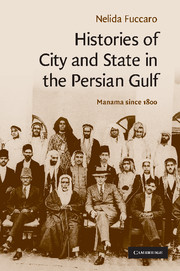Book contents
- Frontmatter
- Contents
- List of illustrations
- List of maps
- Acknowledgements
- Note on transliteration and terminology
- Glossary
- List of abbreviations
- Map 1 The Persian Gulf and Bahrain in the regional context
- Map 2 Bahrain's settlements
- CAMBRIDGE MIDDLE EAST STUDIES 30
- Introduction
- 1 Indigenous state traditions and the dialectics of urbanisation in Bahrain, 1602–1923
- 2 The making of Gulf port towns before oil
- 3 Ordering space, politics and community in Manama, 1880s–1919
- 4 Restructuring city and state: the municipality and local government
- 5 ‘Disorder’, political sociability and the evolution of the urban public sphere
- 6 City and countryside in modern Bahrain
- Conclusion
- Bibliography
- Index of persons, tribes and families
- Index of subjects
- Index of places
2 - The making of Gulf port towns before oil
Published online by Cambridge University Press: 20 January 2010
- Frontmatter
- Contents
- List of illustrations
- List of maps
- Acknowledgements
- Note on transliteration and terminology
- Glossary
- List of abbreviations
- Map 1 The Persian Gulf and Bahrain in the regional context
- Map 2 Bahrain's settlements
- CAMBRIDGE MIDDLE EAST STUDIES 30
- Introduction
- 1 Indigenous state traditions and the dialectics of urbanisation in Bahrain, 1602–1923
- 2 The making of Gulf port towns before oil
- 3 Ordering space, politics and community in Manama, 1880s–1919
- 4 Restructuring city and state: the municipality and local government
- 5 ‘Disorder’, political sociability and the evolution of the urban public sphere
- 6 City and countryside in modern Bahrain
- Conclusion
- Bibliography
- Index of persons, tribes and families
- Index of subjects
- Index of places
Summary
In the Al Khalifah era, Manama developed as part of a network of port settlements which connected the Persian Gulf to the world of trade, merchants and trans-continental routes extending from the Mediterranean and the Red Sea to South East Asia. Viewed from the perspective of this maritime world, these commercial emporia were essentially ‘brides of the sea’. Yet, as clearly suggested by the case of Manama, they also constituted the microcosm of the complex political and economic dynamics which bound coastal societies to their agricultural and tribal hinterlands. That this dual relationship with hinterlands and forelands underpinned the urbanisation of the Gulf coast is evident from the vicissitudes of the tribal and imperial histories of the region before the discovery of oil.
Developments in Bahrain reflected wider processes of political and urban change which were triggered by the resurgence of tribal power throughout the Persian Gulf in the eighteenth century. Alongside the Al Khalifah, a powerful cohort of tribal rulers came to control the Arab coast, favouring the consolidation of a new constellation of maritime outposts. From Kuwait in the west to Ras al-Khaymah in the east, these port settlements under tribal regimes started to compete for the control of regional and long-distance trade with the leading commercial emporia of Basra, Bushehr and Muscat in Oman. As was the case of Manama and Muharraq in Bahrain, fully fledged port towns with complex socio-political organisations only began to take shape in the second half of the nineteenth century under the combined forces of the pearl boom and of British informal empire.
- Type
- Chapter
- Information
- Histories of City and State in the Persian GulfManama since 1800, pp. 43 - 72Publisher: Cambridge University PressPrint publication year: 2009
- 1
- Cited by

